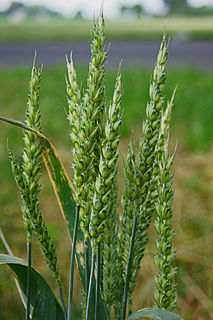
The Poales are a large order of flowering plants in the monocotyledons, and includes families of plants such as the grasses, bromeliads, and sedges. Sixteen plant families are currently recognized by botanists to be part of Poales.

Poaceae or Gramineae is a large and nearly ubiquitous family of monocotyledonous flowering plants known as grasses. It includes the cereal grasses, bamboos and the grasses of natural grassland and species cultivated in lawns and pasture. The latter are commonly referred to collectively as grass.

Stipa is a genus of around 300 large perennial hermaphroditic grasses collectively known as feather grass, needle grass, and spear grass. They are placed in the subfamily Pooideae and the tribe Stipeae, which also contains many species formerly assigned to Stipa, which have since been reclassified into new genera.

Spartina, commonly known as cordgrass or cord-grass, is a genus of plants in the grass family, frequently found in coastal salt marshes. They are native to the coasts of the Atlantic Ocean in western and southern Europe, northwest and southern Africa, the Americas and the southern Atlantic Ocean islands; one or two species also occur on the North American Pacific Ocean coast and in freshwater habitats inland in the Americas. The highest species diversity is on the east coasts of North and South America, particularly Florida. They form large, often dense colonies, particularly on coastal salt marshes, and grow quickly. The species vary in size from 0.3–2 m tall. Many of the species will produce hybrids if they come into contact.

Oryzopsis hymenoides is a cool-season, perennial bunchgrass with narrow, rolled leaf blades. It is native to western North America east of the Cascades from British Columbia and Alberta south to southern California, northeastern Mexico, and Texas. In the wild, it typically grows 4 to 24 in tall and 8 to 12 in wide.

Panicum (panicgrass) is a large genus of about 450 species of grasses native throughout the tropical regions of the world, with a few species extending into the northern temperate zone. They are often large, annual or perennial grasses, growing to 1–3 m tall.
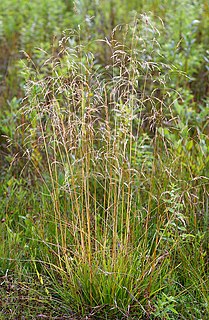
Deschampsia cespitosa, commonly known as tufted hairgrass or tussock grass, is a perennial tufted plant in the grass family Poaceae. Distribution of this species is widespread including the eastern and western coasts of North America, parts of South America, Eurasia and Australia.
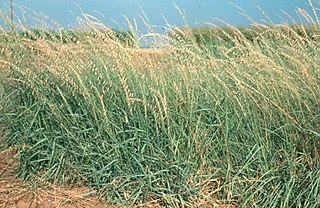
Bouteloua is a genus of plants in the grass family. Members of the genus are commonly known as grama grass.

Nassella, or needlegrass, is a New World genus of over 100 perennial bunchgrasses found from North America through South America. The Latin word nassa refers to "a basket with a narrow neck". It is usually considered segregate from the genus Stipa and includes many New World species formerly classified in that genus. As of 2011, The Jepson Manual includes Nassella within Stipa.
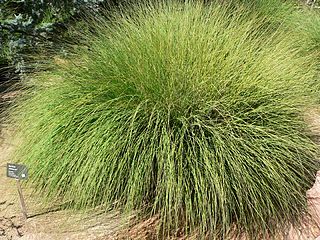
Muhlenbergia is a genus of plants in the grass family.
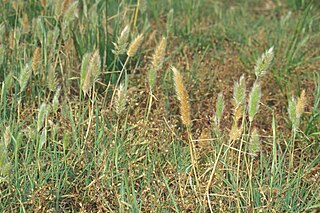
Polypogon is a nearly cosmopolitan genus of plants in the grass family, commonly known beard grass or rabbitsfoot grass.

Axonopus is a genus of plants in the grass family, known generally as carpet grass. They are native primarily to the tropical and subtropical regions of the Americas with one species in tropical Africa and another on Easter Island. They are sometimes rhizomatous and many are tolerant of periodic submersion.
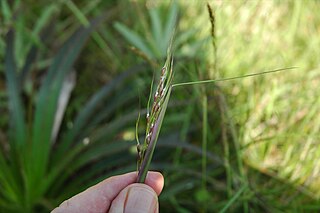
Piptochaetium, or speargrass, is a genus of New World plants in the grass family, native to North and South America. Piptochaetium is a bunchgrass genus in the tribe Stipeae.

Tripsacum dactyloides, commonly called eastern gamagrass,or Fakahatchee grass, is a warm-season, sod-forming bunch grass. It is widespread in the Western Hemisphere, native from the eastern United States to northern South America. Its natural habitat is in sunny moist areas, such as along watercourses and in wet prairies. In some areas, it has adapted well to disturbed conditions.

Chrysopogon gryllus is a perennial bunchgrass of the family Poaceae, native to Europe and tropical and temperate Asia.
Stipa avenacea - renamed Piptochaetium avenaceum, and commonly called black oat grass, blackseed needle grass or blackseed speargrass, is a perennial bunchgrass native to Eastern North America. It is a member of the grass family Poaceae.

Oplismenus hirtellus is a flowering perennial plant from the family Poaceae that can be found on every continent in the world except Antarctica, growing mostly in coastal tropic and subtropic regions as well as tropical and subtropical islands such as Hawaii, New Zealand, Australia and Madagascar.

Hesperostipa is a genus of grasses in the family Poaceae. Members of the genus are commonly known as needle-and-thread grass or needlegrass.

Piptatheropsis is a genus of plants in the grass family.

Nassella tenuissima is a species of grass known by the common names Mexican feathergrass, finestem needlegrass, fineleaved nassella, and Argentine needle-grass. It is native to the south-western United States, northern Mexico and Argentina. It is well-matched to climate in Australia and can be harmful to the Australian environment.



















